Stormbringer 5th Edition / Elric by Traveller
Post 1
Original SA post Stormbringer 5th EditionWe're dead, we're all dead!
Time for a new review! This time, we'll take a look at something that honestly doesn't seem to get much talk in tradgame places, unless you're European or something. Stormbringer is Chaosium's long-running series of sword and sorcery games about Michael Moorcock's Young Kingdoms and Elric, the original brooding anti-hero in black armor with a cursed soul-sucking sword with the original struggle between Law and Chaos. We'll take a look at the last edition made by Chaosium (5th) before it went over to Mongoose and then other publishers. Though, if I have to be precise, I'm not exactly going to be reviewing this:
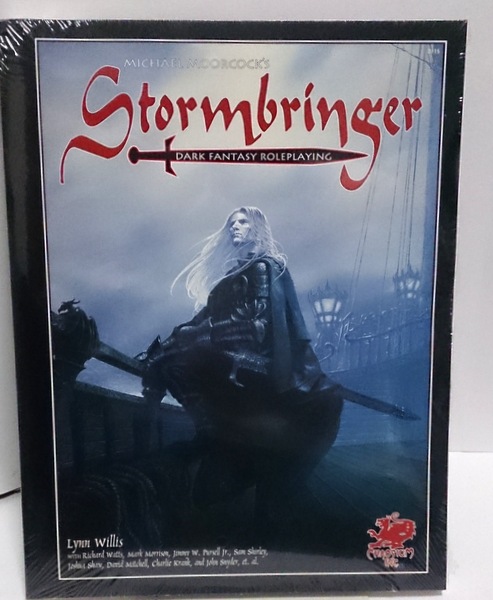
But this:
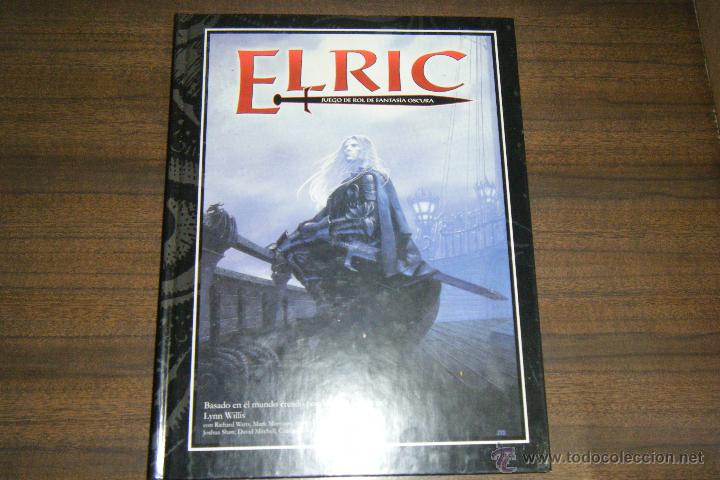
Elric (not to be confused with Elric! - an older edition) is the Spanish translation of Stormbringer 5th, printed by La Factoría de Ideas in 2001. It not only includes the original system and fluff, but also takes the rules from Dragon Lords of Melniboné, a d20 sourcebook for the Young Kingdoms so that people can play with whatever system they want. Hey, it was the early 00s, there were d20 conversions for everything. Like it happens with Call of Cthulhu, Stormbringer 5th maintains a great degree of commonality with previous versions, unlike say D&D. As the game itself says, it mostly balances out certain character options, streamlines some other rules, and adds material from older sourcebooks. The translation itself also gets a word here: many of the terms that had been localized in previous editions of the game and the stories (so Tormentosa for Stormbringer or Arioco for Arioch) return to their original names, aside from adding many notes and examples to make reading the book easier, including references to specific Elric stories from which stuff is taken.
So who is this Elric of Melniboné guy, anyway? He is a "thin-blooded" albino guy, emperor of his wicked realm, and doomed to destroy anything that he loves. In contrast to other sword and sorcery leads (read: Conan), Elric is a thoughtful, brooding sorceror that destroys his realm instead of taking it, and kills his love instead of saving her. He starts as a servant of Chaos, but approaches the Law in his adventures, though eventually he comes to hate the influence of the cosmic forces in mortal affairs. Due to his weak constitution, he must use magic and alchemy to remain alive and active, until he obtains Stormbringer - a magical, wicked blade that steals souls and grants their strength to him. Elric is an aspect of the Eternal Champion , a warrior fated to be a player in the eternal struggle of Law, Balance and Chaos across the multiverse. As the back blurb of the Spanish edition puts it, "being considered a friend by Elric is a synonym for being dead."
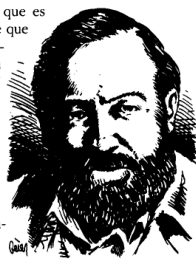
Mr. Moorcock himself.
A quick review of the main Elric stories follows, in chronological order: in Elric of Melniboné , due to the machinations of his evil cousin Yyrkoon he is forced to summon the Lord of Chaos Arioch in order to save his love, Princess Cymoril, and in the process obtains Stormbringer and makes a human friend, Rackhir the Red Archer. At the end of the story, he leaves Yyrkoon as regent in order to adventure outside of his realm for a year. In Sailor of the Seas of Fate , Elric learns something about his true destiny, and joins other aspects of the Eternal Champion to fight beings that threaten the entire cosmos. He later makes friends with Count Smiorgan the Bald and Duke Avan Astran, and in their adventures Elric learns more about Melniboné's past, though the Duke sadly dies. The Weird of the White Wolf sees Elric return along with a fleet of human raiders to raze Melniboné: he's seen that it is an useless relic of the past and has no further place in this world. Yyrkoon has declared Elric a traitor and proclamed himself Emperor in the meanwhile, and in the ensuing battle he gets Cymoril impaled in Stormbringer before dying. The raiders have to escape later, and Elric betrays Smiorgan to survive. He later finds Moonglum, an Eastern adventurer and his best and longest-lasting companion, and has a brief affair with Queen Yishana of Jharkor which gains him the hatred of Theleb K'aarna, a minor but annoying thorn in his side. The Vanishing Tower has Elric meet Myshella of the Dawn, the greatest Champion of Law in the Young Kingdoms, and later on he has to fight Theleb K'aarna again. He finds Tanelorn, a city of peace for everyone, but Elric can't find rest there. Once again he ends up helping other aspects of the Eternal Champion face a cosmic threat, and though he saves Tanelorn at the end Myshella dies and Chaos' influence rises in the world. In Bane of the Black Sword , Elric meets Yishana again and finally kills Theleb K'aarna, though not without cost. He meets a young lady named Zarozinia, and after the destruction of some old civilization or other and saving Tanelorn once more they fall in love and end up living together. His happiness is short lived, as in Stormbringer (the very first Elric story, hilariously enough), she is kidnapped and Chaos invades the world in full. Elric's curse and Stormbringer end up killing everyone that he has ever cared about, and though he manages to find a magic horn that resets the world and keeps Chaos from complete victory, in the end he too is undone by Stormbringer.
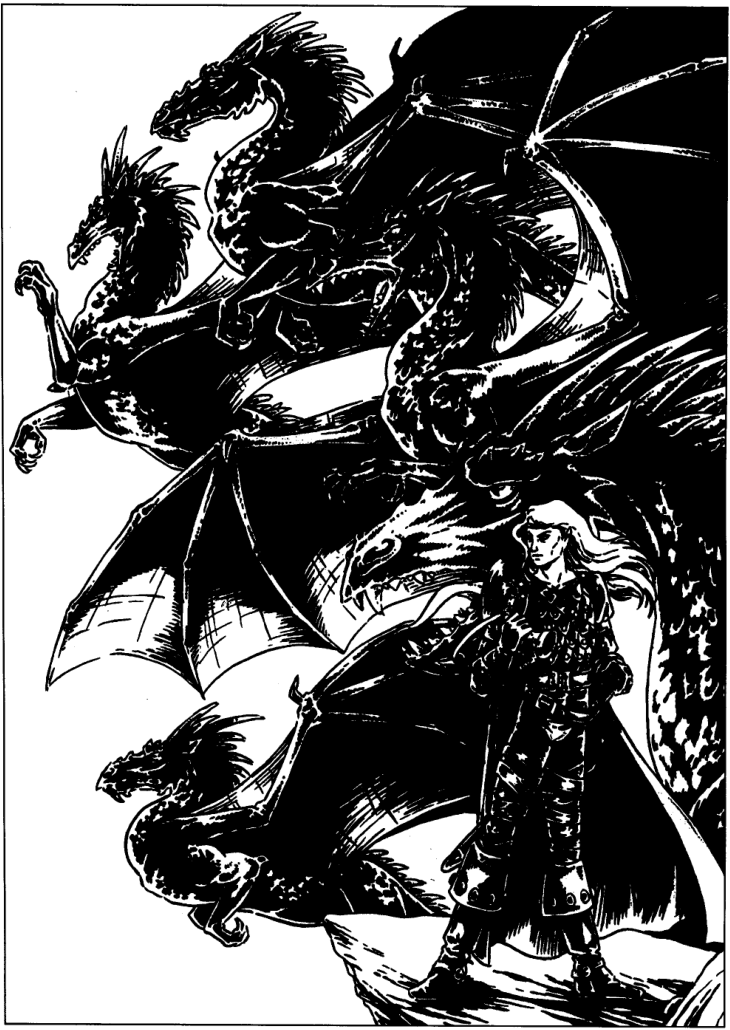
One reason people didn't fuck with Melniboné: FUCKING DRAGONS
So yeah, not much in the way of happy endings, here.
After that, we get the usual "what is a roleplaying game" stuff, along with notes on dice usage, miniatures and the like. It is interesting to note that while the book assume the events happen as the stories say, they're not set in stone and it might be possible for the PCs to stop or escape the Young Kingdoms' ultimate fate. The book does not assume any particular time period for the adventures, though a good starting point is the reign of Sadric, Elric's father: once Elric takes the throne, there's seven years left until the world ends. The translation also notes useful sources for rules, supplements, adventures and inspiration, from other game books and stories to mailing lists and websites, some of which are long gone by now.
The world of the Young Kingdoms (as they are called by the arrogant and ancient Melnibonéan people) is actually our world. In fact, it is due to Elric's final actions that our world exists as it is. Just like our world, Elric's world was too preceded by another cosmic cycle. According to Melnibonéan scholars, the world was created by Chaos, though the rule of the Lords of Disorder has been over for a long time. Apparently there was a race known as the Doomed Folk that lived before Elric's era, that hated the world so much that ended up destroying it and bringing about a new cosmic cycle. The first native races that appeared after the world reset were the Elders , nigh-immortal worshippers of the Law; and the Myyrrhn , winged folk and probably the oldest civilized race of the world. Later, literal aliens arrived to the world, supposedly the Melnibonéan ancestors themselves: the Elders welcomed them and ended up merging their noble lines, giving away the legendary runeswords Stormbringer and Mournblade in the process. The Elders ended up destroying themselves, and the proto-Melnibonéans abandoned the Cosmic Balance to worship Chaos: they grew mighty and built the Shining Empire of Melniboné, which lasted for ten thousand years. Quarzshaat was the first human nation to rebel against Melniboné, but it was destroyed. When the Empire had a hard time fighting the Beastmen of Dharzi, their slaves sensed their weakness, and four hundred years ago the nation of Lormyr threw its shackles off, followed by many others. Melniboné still believes itself to be the ruler of the world, but it is pretty much limited to a single island: the Dragon Isle, where the Dreaming City of Imrryr is still a very important trading hub for the world. The Young Kingdoms are vibrant where Melniboné is lethargic, and Imrryr will not survive the future onslaught. A new merchant class is flourishing, and discoveries and inventions are made constantly: the world is entering a Renaissance. Gunpowder and steam power are still unknown, but clocks, mills and looms are becoming more common, if still infrequent. Naval technology is still very lacking, however, and most nations rely on oar galleys where Melniboné has magic-powered warships. Most of the world speaks the Common Language, a debased form of Low Melnibonéan, and generally everyone can make themselves understood throughout the world. There are rarer tongues like Low Melnibonéan itself, spoken in the Dragon Isle; High Melnibónean, formal and mostly used in sorcery; 'pande, spoken in the Unknown East; Mabden, used in the foreboding isle of Pan Tang; and many others.
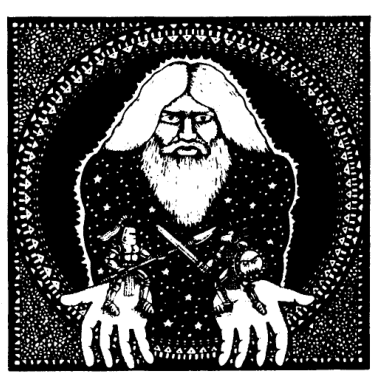
"This is the lay of the multiverse, child: Sigmarine versus Scrunt, locked together in endless battle."
Next: a world of ADVENTURE!
Post 2
Original SA post Stormbringer 5th EditionWarhammer is such an original setting you guise
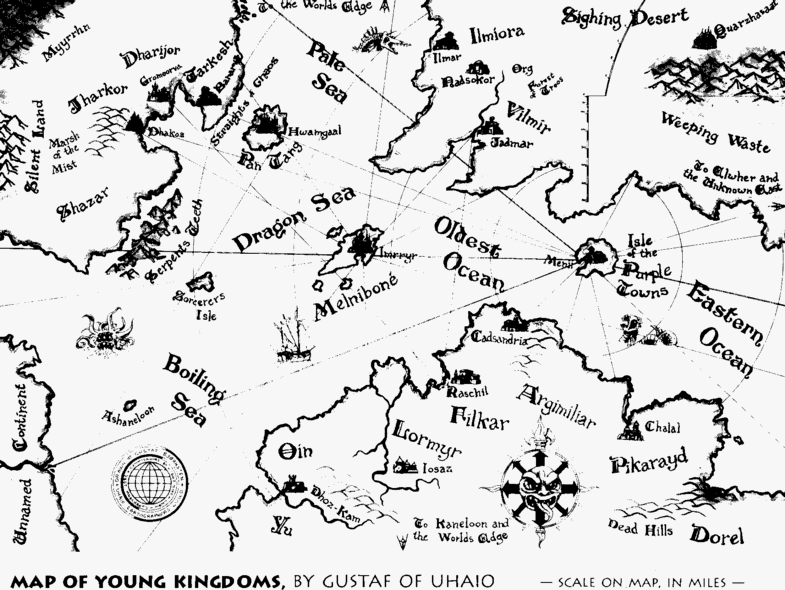
Map!
On to the Young Kingdoms themselves! The world as it is is divided in four continents, of which mankind inhabits three. There are also five major islands, and here is where we'll start. The major island powers include, of course, Melniboné itself. In the fallen years of the Empire, they only really rule over Melniboné itself and other smaller islands that conform the Melnibonéan archpelago, and even then only the Dreaming City of Imrryr has any meaningful population, leaving the rest of the territory abandoned save for the odd poppy field or slave sent to pick up drugs. Said slaves are the backbone of Melnibonéan labor, and are drugged to hell by the true Melnibonéans to keep them docile. Generally the Melnibonéans are arrogant and inhuman assholes that while their days drugged out of their gourds and trying really hard not to think they're not the center of the world any more. They worship the gods of Chaos, particularly their patron Arioch, but they're more completely uncaring that outright evil. That goes for the wicked sorcerors of Pan Tang , another island nation, and one that was actually not part of the world itself but brought along during a planar rift caused in the wars against the Dharzi. Pan Tangian society, while human, is ruthless and only worships the evil aspects of Chaos, so they're basically Melniboné's hick dipshit cousins. Oh, and they will also kickstart the end of the world, bringing a lot of Chaos demons and assholes to murderate everything forever.
 Balancing out these two places is the
Isle of the Purple Towns
, so named because of the purple stone used to build houses and buildings. The Purple Towns are a rising star, made wealthy by trade and commerce, and they're Imrryr's primary rival in terms of trade. Their people are free and bold, and mostly worship the Elemental Lords Straasha and Lassa, though lately the God of Law Goldar has eclipsed the elemental cults. The other two major islands are
Ashaneloon
by the Boiling Sea, relatively unknown but with a castle home to Myshella of the Dawn; and the
Sorceror's Island,
former home of the infamous Cran Liret the Spellthief. Now home to a race of bestial demihumans called Kretii, Elric will slay them before the fall of Imrryr, and after that they will become home to a sect of Lawful hermits shortly before the world ends.
Balancing out these two places is the
Isle of the Purple Towns
, so named because of the purple stone used to build houses and buildings. The Purple Towns are a rising star, made wealthy by trade and commerce, and they're Imrryr's primary rival in terms of trade. Their people are free and bold, and mostly worship the Elemental Lords Straasha and Lassa, though lately the God of Law Goldar has eclipsed the elemental cults. The other two major islands are
Ashaneloon
by the Boiling Sea, relatively unknown but with a castle home to Myshella of the Dawn; and the
Sorceror's Island,
former home of the infamous Cran Liret the Spellthief. Now home to a race of bestial demihumans called Kretii, Elric will slay them before the fall of Imrryr, and after that they will become home to a sect of Lawful hermits shortly before the world ends.
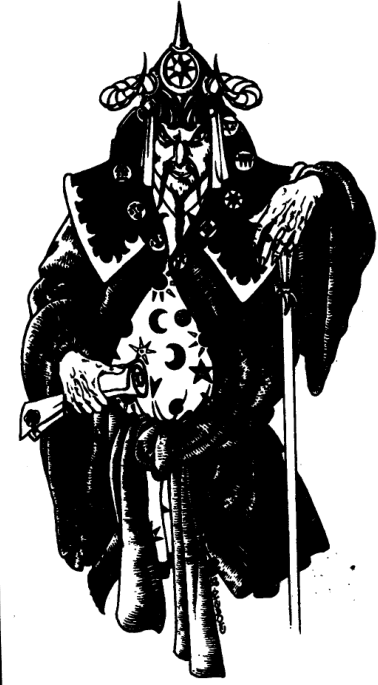
Just in case you didn't realize: PAN TANG ARE THE BAD GUYS.
The South Continent is where the first successful rebellion against Melniboné took place. Major nations are Argimliar , a free-thinking nation famous for its educated populace and universities, that will become much more dogmatic and conservative after its king dies in Elric's raid on Imrryr and a new puritan king takes over. It's notable for having both churches of Chaos and Law active, though Chaos will be outlawed after the change of government. Dorel to the deep South is home to feared raiders and pirates: a superstitious lot that loathes Chaos, being that they live at the World's Edge. And "World's Edge" is pretty literal, since there's straight up nothing but roiling Chaos at the far end.
 They worship Elemental Lords Lassa and Grome.
Filkhar
is a rich land with very high living standards, where the worship of Law is popular and Chaos is considered
demodé.
Lormyr
was the first nation to free itself from Melniboné, and though its star has faded it is a a pleasant and friendly country. While no longer the empire it once was, it still holds great influence in the South. Like Argimliar, its king will die in Imrryr and a new one will take over, who will betray the South and join Pan Tang at the end of the world. Worship of Chaos is forbidden, though not actively stamped out.
Oin
and
Yu
are the poorest nations in the South, and together they share a single depaupered "city", Dhoz-Kam. Their people are primitive and lacking in technology, and no one goes to these places except foreigners that can bully the locals into working for them. Grome, Straasha and Lassa are the main deities here, along with the Beast Lords. Finally there is
Pikarayd
, a harsh land where clans live locked in endless struggles and mercenaries and bandits have a whole sandbox to play with. Lately there's been a new Church of Chaos on the rise here, supported by the tyrannical King Marvos, though two years before the razing of Imrryr he will be ousted by a Balance-inspired revolution. Shamefully, it will all come to naught when the apocalypse comes.
They worship Elemental Lords Lassa and Grome.
Filkhar
is a rich land with very high living standards, where the worship of Law is popular and Chaos is considered
demodé.
Lormyr
was the first nation to free itself from Melniboné, and though its star has faded it is a a pleasant and friendly country. While no longer the empire it once was, it still holds great influence in the South. Like Argimliar, its king will die in Imrryr and a new one will take over, who will betray the South and join Pan Tang at the end of the world. Worship of Chaos is forbidden, though not actively stamped out.
Oin
and
Yu
are the poorest nations in the South, and together they share a single depaupered "city", Dhoz-Kam. Their people are primitive and lacking in technology, and no one goes to these places except foreigners that can bully the locals into working for them. Grome, Straasha and Lassa are the main deities here, along with the Beast Lords. Finally there is
Pikarayd
, a harsh land where clans live locked in endless struggles and mercenaries and bandits have a whole sandbox to play with. Lately there's been a new Church of Chaos on the rise here, supported by the tyrannical King Marvos, though two years before the razing of Imrryr he will be ousted by a Balance-inspired revolution. Shamefully, it will all come to naught when the apocalypse comes.
 There's also mysterious places like Kaneloon, a Lawful stronghold, or the Unholy Fortress of Chaos!
There's also mysterious places like Kaneloon, a Lawful stronghold, or the Unholy Fortress of Chaos!
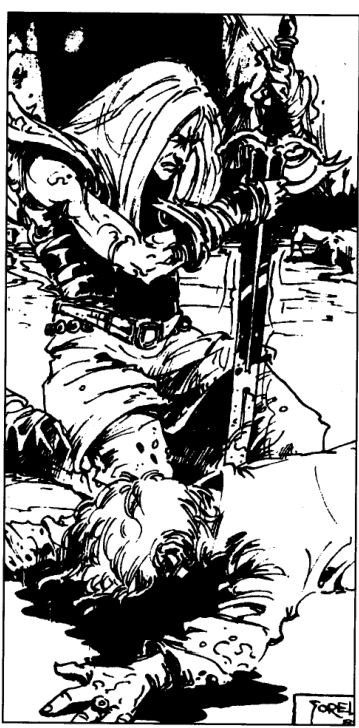
Elric having a snack.
The North Continent is not as wealthy as the South. The very first unsuccessful revolt against Melniboné took place here. Ilmiora is a Lawful nation ruled by a Senate comprising the oldest families across its many city-states. They have an open mind and an intense feeling of independence due to the distance between the city-states, and cattling is one of the foremost economic activities. Nadsokor is a hateful ruin, formerly part of Vilmir but struck by a plague against which neither prayers to Chaos or Law did anything. After people died and the city was abandoned, beggars and other ne'er-do-wells moved in. It reeks for miles, is full of disease, and is the polar opposite of Tanelorn. Its leader is Urish the Sevenfingered, who dies one of the most hilarious deaths in the saga, after which Narjhar the Beggar (a no-shit Lord of Chaos) takes over. Org is another terrible place, whose people has corrupted bodies and behave brutally. There are rumors of necromancy and other sicknesses, and most other people just hope that Org will rot itself inside out if left alone. Its boundary is the Forest of Troos , a sinister place where plants and trees seem to grow by their own rules. Legend has it that it is the last remainder of the previous cycle. Gutheran, king of Org, hates foreigners and orders the death of anyone that wanders into Org or Troos, but he and his family will get a faceful of Stormbringer in later years. The Sighing Desert is dry and unforgiving: it is, in fact, all that is left of Quarzshaat, who fought Melniboné but undid themselves when one sorceror pronounced a single rune wrong in a grand spell. The desert is far from abandoned, however: nomad tribes wander the wastes, claiming to be descendants of people who fled the wrath of Melniboné. They worship no gods, instead seeking personal enlightment. Tanelorn , the Eternal City, can sometimes be found in the desert. It is a place of peace, but ill-loved by both Law and Chaos. It is a refuge for those who flee the world's evils and the demands of the gods. Tanelorn exists, one way or another, in every single world of the multiverse, but merely finding it is a quest in and of itself. Vilmir is a grey nation, where weak-blooded nobles spend their time benefiting from loot brought to them by the corsairs they sponsor and worshipping the gods of Law. Most of the people are peasants that support dying farms and the church-sponsored factories and millworks, and individuality and freethinking are not encouraged in the slightest. East of Vilmir is the Weeping Waste , a vast and mist-covered highland where wandering nomads live. They worship a number of nature spirits, and some even believe that only their desert home is real - beyond it, there is nothing but Chaos.
The West Continent is sparsely populated, with much of its territory still unexplored. The close distance to Pan Tang doesn't help, either. Dharijor is a warlike nation where merchants, artists and poets are loathed and scars and missing limbs are attractive. Pan Tangian advisors from the Church of Chaos are a common sight, and the Theocrat of Pan Tang manipulates King Sarosto as he pleases. Jharkor is a powerful western nation with a large navy and merchant fleet, whose nobles don't think twice of leading peasants to rebellion if they don't like their king. Currently this is the thin Dharmit, but after he dies in Immyrr (Elric fucks up the governments of most nations with his little stunt, really) his "sardonic, sensual" sister Yishana takes over. Of Lawful alignment, the people of Jharkor are famed for being shady and lovers of secrets. Myrrhn to the far North is home to the eponymous winged folk, the oldest civilized race of the Young Kingdoms. They do in fact fly, though there are some Myrrhn that are naturally born without wings. Due to the distances involved and their self-sufficiency, it is rare for them to have much contact with the outside world. They worship Lady Lassa of the Air. Shazar is a land of horse riders and wide plains, and the trade in horse meat and skilled riders makes merchants brave the dangerous Serpent's Teeth reefs down the east coast. Tarkesh is a contrasting land where the north is poor and rough and the south is rich and cultured. They worship Straasha and Grome with breath-taking dancing famous through the Kingdoms, and though they're on the edge of civil war before the razing of Imrryr the new king that takes over after it manages to unite them into a powerful whole, for all the good that it'll do.
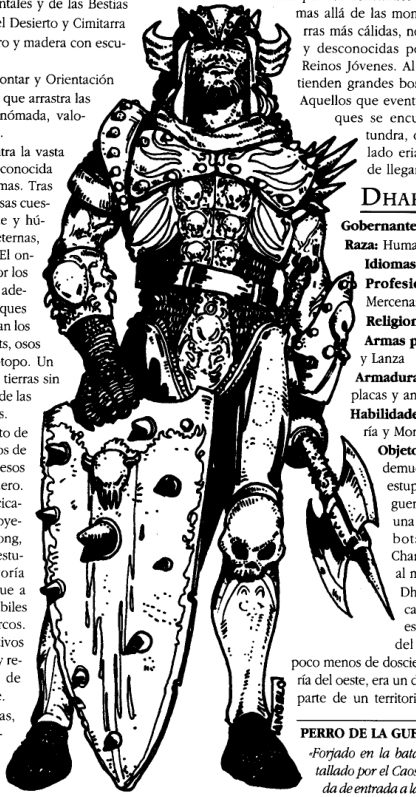
Chaos is the most

Aside from these lands, there's the fourth Nameless Continent , unexplored and mysterious; and the Unknown East beyond the Weeping Wastes, of which the Young Kingdoms know little.
Let's talk about gods and cults! First, there is the Cosmic Balance. It has always existed and it will always exist. It loves everything that exists in the multiverse. It is halfway between Law and Chaos, and its cosmic decrees must be followed by both forces. Law sticks to the letter of the edicts without respecting their spirit, and Chaos actively seeks to undermine these structures: both would topple the Balance if they could. A cornerstone of the Balance's design for the Young Kingdoms are the Beast and Plant Lords , which guard over their respective charges, and the Elemental Lords. Elementals are beings composed of one of the four elements - water, fire, earth and air- and are generally friendly to all living things if somewhat whimsical because they're literally forces of nature. Both Law and Chaos really, really hate elementals. The cult to the Elemental Lords - Straasha of Water , Lassa of Air , Kakatal of Fire and Grome of Earth is common across the Kingdoms but it takes many different forms. In the Purple Towns, the cults to Straasha and Lassa are very organized and formal, while in the Weeping Wastes there's little more than singing, dancing and drumming in honor of Lassa and Grome. There's also the Grey Lords , relatively unknown and mostly influential in Tanelorn, who basically just want things to be peacefully boring for all.
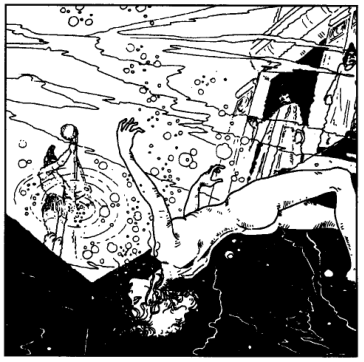
This is the cult of Straasha's idea of initiation: if they don't drown after an hour, they're good.
Chaos is passion, change and power. Weakened through the last five hundred years, Elric's actions eventually allow it to manifest itself more completely into the world. The Lords of Chaos are the deities atop the Chaotic pantheon, usually eight in number depending on the particular Chaotic cult though more are known. Though generally considered evil by humanity, they're beyond good and evil. In large swathes of the world, the cult to Chaos is forbidden and hidden, though some places like Pan Tang have overt churches to it. It is represented by the number eight, and if you're feeling like Games Workshop ripped this wholesale for Warhammer they fucking did. In the rare occasions where they manifest in Melniboné, they take forms of impossible beauty, while in the rest of the world they take on horrible shapes that do little for their PR. The Gods of Chaos are:
-
Slortar
the Old: the oldest god, he is a deity of hedonism and decadence. In Pan Tang, priests ruin their own faces to make Slortar even more beautiful in comparison.
-
Mabelode
the Faceless: sometimes with his face covered in shadows or simply not having one, he is a god of warriors and soldiers. His cult is bloodthirsty but not as much as that of Hionhurn.
-
Chardros
the Reaper: straight up the Grim Reaper, he rules over everything related to the grave and fears of death.
-
Hionhurn
the Executioner: a bloodthirsty giant worshipped by killers and gang leaders, even in Melniboné he's not exactly a pretty sight.
-
Xiombarg
the Queen of Swords: though asexual, she usually takes on female forms and has many worshipper women. She is another war deity but praises cunning over destructive violence. She's also worshipped by those who seek love, or retribution towards former lovers.
-
Pyaray
the Tentacled Whisperer of Impossible Secrets:
 He also has the so-called Fleet of Chaos, and when it shows up at the end of the saga it is pretty much "yup, the world IS ending." Straasha is his foremost rival.
He also has the so-called Fleet of Chaos, and when it shows up at the end of the saga it is pretty much "yup, the world IS ending." Straasha is his foremost rival.
-
Balaan
the Grim: BDSM the God, basically. Loves pain in every form. In Melniboné he wears the face of a beautiful mortal plasted over his face like a mask.

-
Arioch
Lord of the Seven Darks, Knight of the Swords, etc.: one of the most powerful dukes of Hell, patron of Melniboné and Elric himself. A cruel jerk, he also keeps the runeblades Stormbringer and Mournblade.
-
Eequor
the Blue Lady: she lives in a domain where there's only shades of blue. She's a goddess of knowledge and loneliness, and enjoys cold weather. Even in Pan Tang, where women are not allowed to practice sorcery, her cult flourishes.
-
Narjhan
Lord of Beggars: usually manifested in the form of a towering armor with a deep voice, he once lead an army of beggars to destroy Tanelorn in person, and his cult thrives on the fear and hatred of ugliness and deformations.
-
Balo
the Jester: not quite a Chaos Lord, he moves between the realms of Chaos and Law at will. A real funny guy, though his jokes are kind of deadly to mortals. His followers are absolutely insane.
The Lords of Law stand in opposition to Chaos. They're sometimes known as the White Lords and associated with goodliness and stability by humans, but they're every bit as uncaring and beyond good and evil as their Chaos counterparts. Where Chaos is constant and meaningless change, Law is perfect stagnation. Its symbol is a single arrow pointing upwards. Law has many sacred numbers: 1, because it's the first one and it's single; 3, because it's one of the first prime numbers and represents the triangle, the strongest structure; and 9, which is three times three and thus three times as holy, and conveniently enough the number of deities in the Lawful pantheon. Some Lawful cults to demigods and heroes exist. The translation here notes that of the entire pantheon, only Donblas and Arkyn are Moorcock's creations: the others have been added across the several editions of the game.
-
Donblas
the Justice Maker: Donblas gives victory to those who deserve it by challenge. He represents the relentless machinery of justice. His priests are often lawmakers and judges, and his clerics are paladins, crusaders and zealots.
-
Arkyn
the Thorough: he's a god of philosophers, alchemists, mathematicians and inventors. He controls the tides, planetary orbits and seasons. He's the god of

-
Goldar
Lord of Progress and Wealth: A god of commerce particularly worshiped in the Purple Towns. By accumulating wealth, their followers become more perfect and virtuous.
-
Mirath
of the White Hands: the Lawful deity of death and time, Mirath determines how long each creature must live. She can be both cruel and compassionate. Her followers are present in weddings, births and funerals, and also practice the arts of healing since in the end if Mirath wants a life cut short she will not be denied.
-
Tovik
the Merciless: he represents the savage laws of nature, and is worshiped by warriors and warlords. His wild, stern-gazed priests drive armies to Mirath's belly.
-
Vallyn
the Wise: she's the goddess of knowledge and learning. She demands loyalty and discipline from her followers, and those especially loved by her may receive answers in the form of dreams.
-
Salik
the Potent: a deity of agriculture and breeding, prayed to by men to sire children and make their fields and animals fertile. He taught humanity how to brew beer and harvest grapes, and has few female worshippers.

-
Theril
of the Guiding Hands: a muse for poets, painters, authors and musicians. Unpopular in Vilmir. She gave musical tablature to mankind, and she's quick to abandon lazy artists that fail to heed her calls.
-
Elgis
the Gentle: a deity of peace and civilization, his worshippers bring peace and harmony to the world and drive back the disorder of Chaos by extending civilization among barbarians.
After that we get a long description of the churches of Straasha and Goldar in the Purple Towns, as well as the Church of Chaos in Pan Tang and the Brotherhood of Tanelorn in, well, Tanelorn. But this post is getting long anyway! It's interesting to note that the newfound popularity of Goldar's cult is driving a wedge between the cults of Straasha and Lassa, since Straasha was usually followed by peasants and Lassa by nobles - but if Goldar can lift a peasant to wealth and a good life, isn't he better than noble Lassa? Meanwhile, the Church of Chaos is surprisingly bureaucratic for a thing called the Church of Chaos , since humanity in the end tends to bureaucracy and balance. There are many ranks and degrees to obtain, and initiates must have a minimum of spellcasting ability if they want to do anything other than cleaning floors.
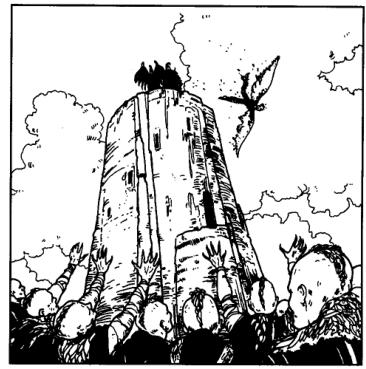
Goldar can make you wealthy, but Lassa lets you fly. You ARE a faithful of Lassa, random novice, right?
Next: some fucking rules, at last
Post 3
Original SA post Stormbringer 5th EditionPledging your soul to forces beyond your ken for fun and profit
Time to make a character! Something I really, really like about the game is that there's a whole flowchart spread across two pages with all the instructions you need to make a character with minimal back and forth flipping. Depending on your character concept, you might not need to flip pages at all, just reference the flowchart and your own character sheet. Characters are defined by seven stats: STR ength, CON stitution, SIZ e, INT elligence, POW er, DEX terity and APP earance. One 2d6+6 roll for each, for a 8-18 spread - no INT 3 goons here. Up to three points can be redistributed around all stats except POW. Many times stats are multiplied by a given factor in order to have a number to roll when a skill isn't appropriate, and four of these rolls should be precalculated now: Idea (INT x 5), Luck (POW x 5), Dexterity (DEX x 5) and Charisma (APP x 5). A minimum of 16 POW is needed to cast magic, and if you want your adventurer to be a caster but don't have the points to do so you can trade two points from other stats into a single bonus POW point. A successful Luck check is necessary every time this is done (once the Luck check is failed, no more attempts can be made), and it adds a Chaos point every time this is done. More on this later.
STR+SIZ gives the character's Damage Bonus. (CON+SIZ)/2 gives the character's Hit Points. HP in Stormbringer are a more direct representation of vitality and health than in, say, D&D: many poisons and diseases directly reduce HP instead of going after stats and the like. A character's Magic Points equal their POW. MP are used for casting and resisting spells. At this point, the character starts taking shape - gender is chosen, though it has no mechanical effect. You can roll or choose one of four Backgrounds that give a 20% bonus to a number of related skills: you can solve things through physical strength, finesse, deceit or persuasion. This is unrelated to a character's Profession , what they did before they turned to the adventuring life. Characters get 250 points for their profession's skills, as well as some money. If so wished, they may roll for their profession in one of two tables: one is completely random, while the other is "realistically" weighted (as the game itself points out, the most likely outcome in this table is being a peasant or farmer
 ) Professions also come with up to three spells that characters
may
take, but they're strictly optional. Some Professions also have special rules: shamans and priests start with more allegiance points, while if a beggar
fails
a Luck roll they have contacts in Nadsokor. There's an optional Distinctive Traits table to roll on, then a character gets their
age
by rolling 1d6+17. That same d6's result is multiplied by 30 to get a character's starting money. Characters may roll more d6s to grow older and get more skill points (10 per roll) but after five rolls they start losing stat points.
) Professions also come with up to three spells that characters
may
take, but they're strictly optional. Some Professions also have special rules: shamans and priests start with more allegiance points, while if a beggar
fails
a Luck roll they have contacts in Nadsokor. There's an optional Distinctive Traits table to roll on, then a character gets their
age
by rolling 1d6+17. That same d6's result is multiplied by 30 to get a character's starting money. Characters may roll more d6s to grow older and get more skill points (10 per roll) but after five rolls they start losing stat points.
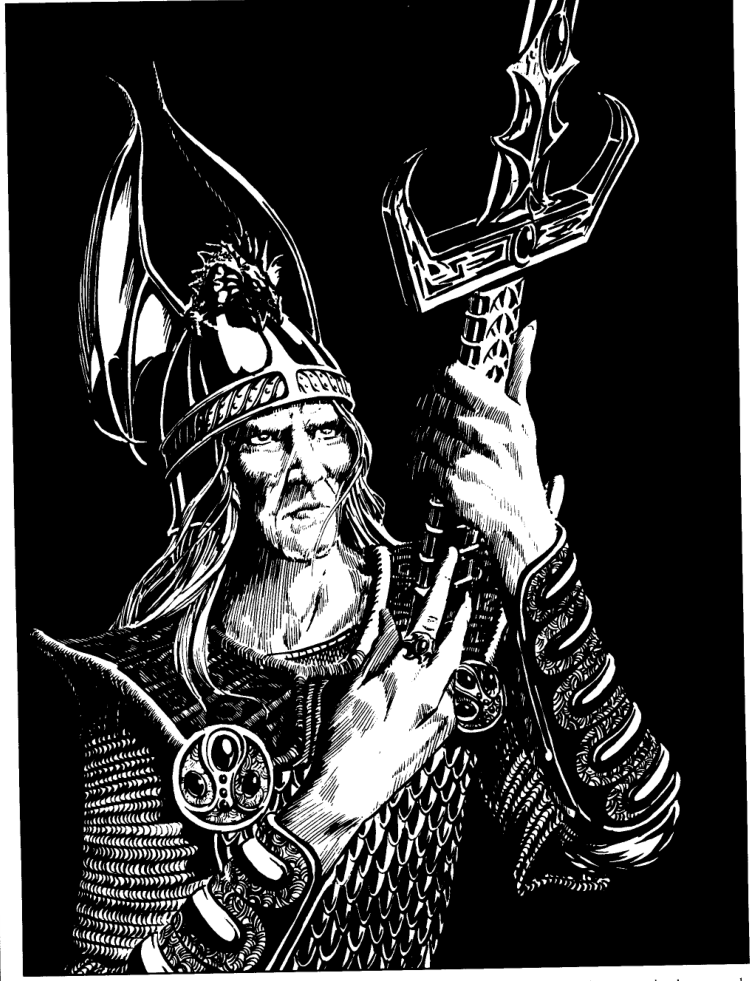
Elric that's not how seppuku works come on
Characters that don't get spells may choose to start following the Law (20% bonus to 1-3 skills, +1 Law point per bonus) or the Balance (+1-3 bonus to their lowest stat, +1 Balance point per bonus) Finally, characters get 600 bronzes specifically to purchase armor (though they can pocket that money), and they start with a horse, a saddle and every weapon whose skill they give at least 20 points. They also get a memento from their family worth 1d20-1 bronzes. Finally, the character picks their homeland, which is kind of weird as the description for each nation and kingdom comes with favored skills, weapons and traits. You'd think this step would be taken early on, but that's how Stormbringer rolls. There's also a table to roll for, but players should ask their GM for permission if they want their characters to be from Melniboné or Pan Tang.
So what's with these Chaos and Law and Balance points, anyway? They are part of the Allegiance system. From their choices during chargen, each character starts with a tendency towards one of the three cosmic forces. The greater the number of points of one flavor, the greater the loyalty of the character to that force. However, most people don't act in the same manner all the time, and it's perfectly possible to have points not just in one force, but two or even all three. When a character has 20 more points in their highest allegiance than the next higher, they're considered to be allies of that force. Allegiance points are gained by allegiance checks done after an adventure: the GM asks for a d100 roll, and if the character gets less than their allegiance score they gain 1d8 points (Chaos) or 1d6 points (Balance, Law.) Some actions can gain points directly: for instance, knowing or casting spells is always a Chaotic act. Points can be lost if the GM considers a character is going against their allegiance (same check as gaining allegiance points, only the 1d8 or 1d6 bonus is a reduction) or by outright reducing them without a roll. This is more or less safe unless the characters have scores of one hundred or more, in which case they really should consider going against their cause.
A character that is allied to Chaos can, if they run out of Magic Points, pray to Chaos and gain 1/10 of their current Chaos score in MP. This can be done up to three times per session of game, and only after the third time does the character fall unconscious (normally, a character that hits 0 MP is knocked out) The character must succeed at an allegiance check at the end of the adventure, and they may try calling on a specific Chaos Lord with 1% chances of success. A character that is allied to Balance can, once a session, restore 1/5 of their Balance points in HP. They must pass an allegiance check at the end of the session. Allies of Law can pray to the White Lords to add their full Law score to a skill. This must be done before a roll, and can be done up to three times per session. These rolls don't get an experience check. Like their Chaos counterparts, they have 1% of chances of having their call to a Lawful god heard.
Characters with 100 points or more in one of the three forces get a powerful vision asking them if they want to undergo Apotheosis and become a champion of that force. Scores in the other forces don't matter. The character must prove that they are worthy of such an honor and they must also want it. If they reject it, their scores continue increasing as normal until they die or retire. Law and Chaos attempt to persuade, tempt and charm the character into accepting apotheosis; Balance doesn't force the issue but every few sessions an APP x 2 roll (later APP x 4, APP x 6, etc.) is made for the character to find their true love. The Balance loves love, after all, and there's always the chance of protecting said love in Tanelorn. :hug:
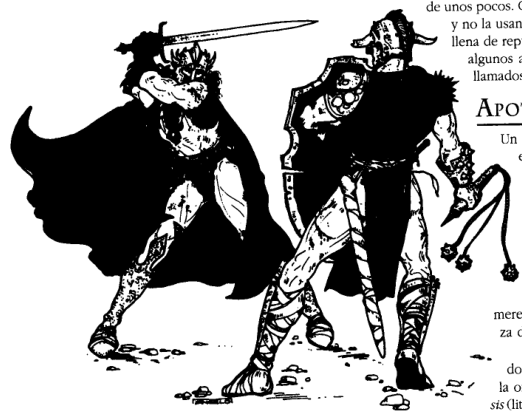
My allegiance is to Star Wars, Trekkie scum.
A Champion of Chaos can, if they die, roll under (POW x 1d8) and if they succeed they vanish in a stinking cloud reform at the place of their apotheosis eight days later, losing a single APP point in the process due to the horrible pain involved. If this roll fails, they ascend to some superior plane to become a loyal pet of their patron.
 Their MP are doubled, and they must choose a Lord of Chaos as a patron. They get POW x 3 chances of their Lord hearing their call if their need is great, but that doesn't mean their patron will do anything to help them (Elric got ditched by Arioch many, many times) A Champion of Balance becomes worthy of seeking Tanelorn, which involves a long quest that reveals the character's place in the world. If they succeed, they win the cosmic game and escape the fate of the Young Kingdoms. Their HP are now straight CON + SIZ, no averaging. A Champion of Law can go to the World's Edge and shape new lands from the formless Chaos there. 1d100 + 160 square kilometers, full of animals and plants as the Champion wishes, and even a small populace to rule. Three skills get their scores doubled, and like the Champions of Chaos they must choose a patron to call on in times of need, with the same POW x 3 chances. And just like Chaos, the Lawful gods may just proceed to ignore said need.
Their MP are doubled, and they must choose a Lord of Chaos as a patron. They get POW x 3 chances of their Lord hearing their call if their need is great, but that doesn't mean their patron will do anything to help them (Elric got ditched by Arioch many, many times) A Champion of Balance becomes worthy of seeking Tanelorn, which involves a long quest that reveals the character's place in the world. If they succeed, they win the cosmic game and escape the fate of the Young Kingdoms. Their HP are now straight CON + SIZ, no averaging. A Champion of Law can go to the World's Edge and shape new lands from the formless Chaos there. 1d100 + 160 square kilometers, full of animals and plants as the Champion wishes, and even a small populace to rule. Three skills get their scores doubled, and like the Champions of Chaos they must choose a patron to call on in times of need, with the same POW x 3 chances. And just like Chaos, the Lawful gods may just proceed to ignore said need.

This chapter ends with some survival tips: try to have a weapon skill with 101% or better ( 101%? oh, yes, skills can go over 100%.), invest in shields and armor, get a really high POW if you want to work serious magic (mind the Chaos points!), have some talky skills, ask first, don't fight if you don't know what your opponent is, take care of your friends (here it mentions how while characters may have different allegiances, they don't have to stab each other at the earliest convenience, though like Elric realizes all the Law vs Chaos conflict really does is driving wedges between people) and, if everything fails, try to get captured and ransomed back to safety. Prices for stuff are given in bronzes , metal coins that are worthy enough to be useful without your losing your month's wages if you lose one. The game assumes money works the same across the world rather than sticking to different monetary schemes from place to place, but characters are warned not to, say, spend Melnibonéan coin in Vilmir. Skills are similar to other BRP games, but the list itself is shorter compared to other games. Many distinct skills are rolled into umbrella skills, like Art or Trade. There is no distinct Martial Arts skills, instead characters deal more damage with unarmed attacks once their Brawling hits 101% or better. There's the Repair/Invent skill, that is based off DEX x 4 and never increases by any reason except DEX raises. And then there's the Fly skill, that is pretty useless to anyone that isn't a myyrrhn character.
So, on to the game system! Generally, things are not rolled for every single action PCs can take, only if the action is extraordinary or dramatic. Some stuff, like weapon skills, is always rolled only in extraordinary or dramatic circumstances. To make a skill check, roll a d100 and try to get equal to or under the skill. This is a success... well. There are several degrees of success and failure in Stormbringer. Rolling equal to or under the skill is a plain success ; rolling equal to or under 1/5 of the skill is a critical success ; and rolling a 01 in an attack roll with certain weapons gets an impaling success. On the other hand, rolling over the skill is a failure ; while rolling 99-00 in a skill with 100 points or less (only 00 with a skill over 100 points) is a fumble, and that's not good. Crit successes work better than regular ones, while fumbles are just awful. Sometimes characters may end up opposing each other just using their stats: to use the old RPG example, two characters engaged in arm wrestling. In this case a Resistance roll is made of (50% + Active Stat x 5 - Passive Stat x 5), though there's a table that you can reference straight away instead of adding and subtracting numbers. Experience checks are indicated by the GM as the adventure proceeds for skills used in play: roll a d100 for them at the end of the session, and if the roll goes over the skill then it gains 1d10 points. For skills over 100-INT, they have to make an INT x 1 regular roll instead. Characters may also train under masters: this takes time, money, and can only increase a skill up to 80%. Stats can be increased by resistance checks against enemies that have a greater score in the stat. They can go up to 21 points for humans, except INT and POW which are uncapped. STR, CON and APP can also be increased by training. Yes, APP, you fucking goons. You can learn to shave your neckbeard.
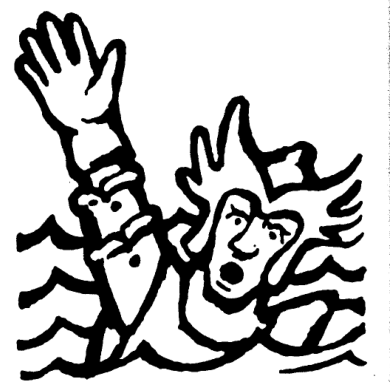
Look at it. Just look at it! All the art in the book is various flavors of grim and/or dark, and then there's this.

Wounds! As said before, a character's is a representation of their health and stamina. A light wound is one that takes less than half of their HP. They don't impair the character, but if they take enough for a severe wound they must roll POW x 4 to remain conscious. Enough light wounds can leave a character unconscious at 2 HP. Severe wounds take more than half of a PC's HP, and they're bad. There's a Severe Wounds table to roll on if they fail a Luck roll: it always involves stat point loss, though sometimes the blow is enough to knock the character then and there and sometimes they can continue fighting for a number of rounds equal to however many HP they have left. A fatal wound deals more damage than the character has HP left. If they aren't restored by first aid or magic to positive points by the end of the round, they die.
Next: we're going demon summoning! Also, fighting!
Post 4
Original SA post Stormbringer 5th EditionBlood for the blood god, etc.
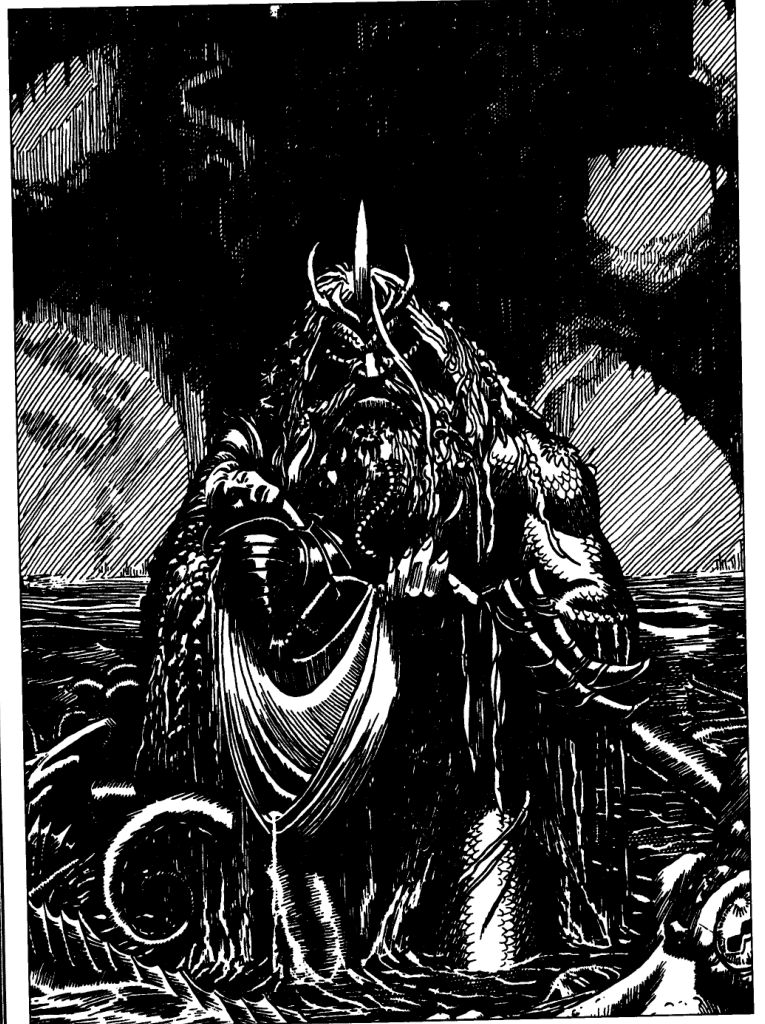
That was the last time Lord Straasha invited Elric to a kegger. Fucking prettyboy can't hold his drink for shit.
Time to get into combat! It is divided into rounds , each further subdivided into declarations , magic , actions and resolution steps. In one round, an adventurer can move up to their MOV e stat: MOV is the same for all characters at 8, so it's not included in the character sheet. Other creatures can have other MOV scores. Movement is very abstracted, there are some suggestions on how long the "units" you can move actually are, but the stat is generally there to compare relative speeds in chases and the like. Though you could go all tacticool and whip out the miniatures and terrain if you wanted to! Characters can move up to half or less of their MOV and still have time to strike or perform some other action. Physical actions take place in the Actions phase according to the initial declarations, but the game says that actions can be cancelled or targets changed more or less at will. Characters act according to DEX ranks, with highest DEX going first and then counting down until hitting DEX 1. Most actions take 5 DEX ranks to happen, except for reactions like parries and dodges. A place where rules get kinda fucky here is with projectile weapons, since they always go first, and long-reach weapons like spears that go before shorter reach weapons. Long-reach weapons have the disadvantage that they can't be used in close quarters (an opponent can get in close with a successful Dodge), with the explicit exception of quarterstaves and great swords because this game is called Stormbringer.

To attack , roll your skill as usual. 01 is an impaling crit (roll damage twice, armor is ignored), 1/5 of the skill is a critical (double damage, armor still counts), over that but equal/under the skill is a hit (roll damage once), over the skill is a failure and 99 or 00 is a fumble. Of course, given that 100%+ scores are relatively common, this roll will almost always succeed, which is where parries and dodges come into play. As long as a character knows they're under attack, they can attempt to dodge (roll the Dodge skill) or parry (roll the relevant weapon skill) the blow. Parries can crit just like regular rolls: an impaling hit can still be parried by a critical defense roll. However, every parry or dodge after the first one reduces the chances in 30 points for both skills, so a warrior can be overwhelmed by a flurry of blows. Furthermore, a weapon may break even if a parry succeeds if the damage dealt by the attacker goes over the weapon's hardness. Shields behave in a similar manner, but they only lose hardness points instead of suffering immediate existence failure and they have much more of them than weapons, so they last longer than parrying weapons in combat against heavy weaponry. Some weapons aren't designed to parry at all, and they always lose hardness points on a parry. With over 100 points in a weapon skill, attacks can be divided into two or more: following attacks take 5 DEX ranks and must have at least 50% of skill to happen. So it's the character's choice if they want to spam blows or conserve their effort and make sure they have enough points to make crits more likely.
If everything fails, there's still armor. Armor in Stormbringer isn't a fixed measure of protection: instead, it has an armor roll just like a weapon's damage roll. The heaviest armor, Melnibonéan plate, can protect up to 1d10+6 damage - but there's always the chance of rolling low, meaning a chink in the armor or an exposed joint for the attacker to seize. Armor also comes made for a defined SIZ, but usually it can be adjusted one or two points up or down with belts. There's magic Hwamgaarl plate that always fits the character, but it also comes with a corrupting Chaotic effect that makes characters lose points in Law or Balance, which might be a desired effect anyhow.

After that there's a couple of pages describing weapons and armor. Something neat is that some weapons are grouped in common categories, and the skill in one of them is shared with the others in the group so you don't get a situation where you lose your heavy mace, grab a club and suddenly end up not knowing what the business end is. It is also noticed, in ALL CAPS, that crossbows DO NOT exist in this universe. Then there's a Special Situations chapter with a whole mess of miscellaneous rules, which really makes the underlying BRP system show its age: it reads like the collective experience of GMs across the years dealing with players and shenanigans. Here you have a rule for ambushes, here's a rule for underwater combat, here's a rule for firing at sngles over 45° up (-20%) or 45° down (-30%). Here's a rule for volley firing, here's one for diseases, one for fighting prone and one for the dangerous myyrrhn maneuver of using their special dive lances to drop on an opponent and stabbing them from above: double damage, tripled on a crit; Luck roll to retrieve the weapon, then Fly roll for the myyrrhn to land safely - critting this roll lets the character fly off and gives +10 to Charisma rolls with other myyrrhn that see this stunt because so fucking cool but failing it turns the bonus into a penalty and makes the character fall on the enemy like a sack of potatoes. A scary experience can send a character into catatonia, of which they can only be shaken out with a Luck roll or waiting it out for days - or you can port the old Mental Health system from older Stormbringer versions or just snatch Call of Cthulhu's Sanity, no biggie.
Wait, what's with the Magic phase, you ask? Well then! Magic, as mentioned earlier, requires a minimum of 16 POW to be used. Magic takes Magic Points to be used, and some special magic needs the sacrifice of actual POW points. Characters with POW 15 or less can't cast spells, but they still can have beneficial magic effects cast on them and they still have their MP. Magic comes in the form of spells , calls , summons and enchantments. The latter is GM-only, and a single character can keep up to their INT in the first three. They can have a grimoire to store magic rituals for later. Learning magic can happen due to research, finding someone else's grimoire and reverse engineering it, getting a teacher or as a gift from a deity (with some heavy strings attached, usually.) First, there's spells. These are very low-key powers that don't require calling on any outside forces, though every use of a spell is a Chaotic act. There are three Lawful spells that can only be used by a character that is allied with Law, but even those are Chaotic to use (a Lawful character should only resort to these as a last-ditch resource). Spells only take MP to use, normally no rolls are involved, and in combat they take a full round to cast from Magic phase to Magic phase (INT order instead of DEX to determine what spells go off first); any hit hard enough to make a caster lose 1HP loses them the spell. The spells themselves aren't really caster supremacy or anything: mostly they're buffs and utility spells. There's one spell per stat that buffs them temporarily (Beauty of Arioch for APP, Soul of Chardros for POW, etc.) with the risk of the buff becoming permanent at the expense of other stats if the spell is used at max power and a percentile roll of 00 is made. There are a number of spells that buff armor and weapons, though interestingly enough they buff their minimum rolls instead of being a straight bonus - so if a heavy Lormyrian axe deals 3d6 damage and a three-MP Hell Blade spell is cast on it, the weapon deals 6-18 damage. There's one spell for each element, a number of "thief" spells named for Cran Liret that buff skills like Climb or Hide, assorted utility spells, and very few offensive spells that are more in the way of debuffs than Magic Missile.
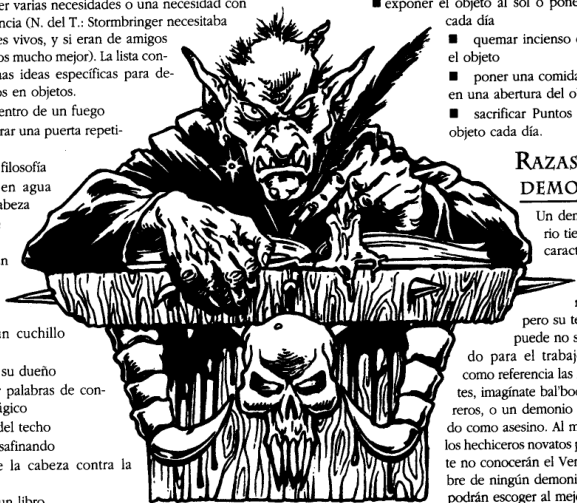
Zyg-Yat the Thrice-Bound, doing your taxes.
But Stormbringer is notorious for stories about sorcerers holding their entire 'fellow' party under their thumb or wiping them out easily, so what gives? This is where summoning comes into play. The spell Summon Demon lets a caster, well, summon demons. It's a very complex procedure, and can probably grind a session to a halt if the GM is not ready for it. Basically, demons are created by the caster, who sacrifices enough MP to give them stats (which are rolled just like PC stats, only with d8s instead of d6s), skills and demonic powers. Powers is where the real ultimate power is as far as Stormbringer magic is concerned, since they allow stuff like scorching or freezing a target, smash them with tentacles, outright sap their MP or POW, the works. There's also a number of utility powers which come very handy. To compensate, summoning demons is very intensive in terms of MP - probably more than the average caster possesses personally, though there are certain spells like Brazier of Power or Chain of Beings that allow the caster to save MP or use the MP of others. It also takes a lot of in-game time, at least 1d8 hours of preparing a summoning octagon, burning the appropriate
 , mumbling nonsense and so on. And then there's a Luck roll to be made, otherwise the demon just plain doesn't show up (woe betide the caster if they fumble this roll: there's a table... and one of the possible results is "caster turns inside out - they can live and function normally but their APP is zero
, mumbling nonsense and so on. And then there's a Luck roll to be made, otherwise the demon just plain doesn't show up (woe betide the caster if they fumble this roll: there's a table... and one of the possible results is "caster turns inside out - they can live and function normally but their APP is zero
 ). Once it's summoned, the demon can be
bargained
with: this requires skills like Persuade or Fast Talk, but is generally free to do. Bargaining requires a single defined task of the demon in exchange for something else, usually fulfilling their
Demonic Need
: a compulsion that demons have, from chatting with them about philosophy to eating small animals and so on. Generally the bigger and meaner the demon, the harder the need. If the caster wants a more permanent arrangement, the demon can be
bound.
This requires sacrificing one POW point and engaging the demon in a POW vs POW resistance roll - the caster did use the Witch Sight spell to look at the demon's POW first, right? - but if the demon loses it gives up its True Name and can be summoned or dismissed at will. An
Eternal Binding
ties the demon to a place or object, and costs three POW points but has the advantage that it cannot be undone short of destroying the place or object, while regular bindings can be undone by killing the demon, the binder, or getting the demon's True Name and binding it again. The book says that bound demons that don't have their Need sated can't do anything about it but are generally surly and unhappy, and if truly desperate they can try giving up info on their master or even straight up surrender their True Name in hopes that their master's enemy is nicer to them. There are some
demon races
defined: the game admits this isn't strictly part of the saga, but it's useful. Basically a demon race's stats are relatively well known by summoners, including the MP necessary and their Needs, so they're a good way to getting a demon that you know is good for the job if you don't have any True Names handy and don't want to risk the randomness of regular summoning. The game includes bal'boosts (83-MP combat monsters that eat one goat or bigger a day), dhzutines (tiny nimble demons usually bound to gloves to help with complex somatic components), hoojgnurps (slime monsters, basically) errant demons (whose main schtick is that they can pass for humans) and servant demons (generic minions that just need a cup of tea leaves to eat per day)
). Once it's summoned, the demon can be
bargained
with: this requires skills like Persuade or Fast Talk, but is generally free to do. Bargaining requires a single defined task of the demon in exchange for something else, usually fulfilling their
Demonic Need
: a compulsion that demons have, from chatting with them about philosophy to eating small animals and so on. Generally the bigger and meaner the demon, the harder the need. If the caster wants a more permanent arrangement, the demon can be
bound.
This requires sacrificing one POW point and engaging the demon in a POW vs POW resistance roll - the caster did use the Witch Sight spell to look at the demon's POW first, right? - but if the demon loses it gives up its True Name and can be summoned or dismissed at will. An
Eternal Binding
ties the demon to a place or object, and costs three POW points but has the advantage that it cannot be undone short of destroying the place or object, while regular bindings can be undone by killing the demon, the binder, or getting the demon's True Name and binding it again. The book says that bound demons that don't have their Need sated can't do anything about it but are generally surly and unhappy, and if truly desperate they can try giving up info on their master or even straight up surrender their True Name in hopes that their master's enemy is nicer to them. There are some
demon races
defined: the game admits this isn't strictly part of the saga, but it's useful. Basically a demon race's stats are relatively well known by summoners, including the MP necessary and their Needs, so they're a good way to getting a demon that you know is good for the job if you don't have any True Names handy and don't want to risk the randomness of regular summoning. The game includes bal'boosts (83-MP combat monsters that eat one goat or bigger a day), dhzutines (tiny nimble demons usually bound to gloves to help with complex somatic components), hoojgnurps (slime monsters, basically) errant demons (whose main schtick is that they can pass for humans) and servant demons (generic minions that just need a cup of tea leaves to eat per day)
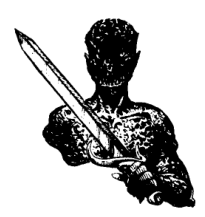
Bal'boosts look pretty naff for how tough they are in game. I know the scan is shit but they don't look much better in print, honestly.
The alternative to demons is elementals. Summoning an elemental requires the Summon Elemental spell and the elemental spell related to the summon (so Bounty of Straasha for undines). It only takes 1d6 rounds, no Luck roll is needed, and they can be modified by adding extra MP to the summon. The least summonable elementals cost 28 MP. The available elementals are gnomes of Earth, undines of Water, salamanders of Fire and sylphs of Air. Like demons, elementals can be bargained with, but they're generally more amenable to it as long as the summoner isn't asking stuff that is self-destructive or contrary to their interests. A gnome would be glad to dam up a stream of water, but wouldn't be as happy to break up earth to increase the stream's flow. Elementals can be bound, but this kills their usual joy to do stuff: they can perform a number of "simple tasks" (simple being "what seven humans working non-stop can do in seven days and nights") up to their CON before dying, and the action costs one Balance point. Also, good going, you're going on an Elemental Lord's bad book.
 Only an Elemental Lord can teach an elemental's True Name. Aside from gnomes, all elementals are immune to physical attacks.
Only an Elemental Lord can teach an elemental's True Name. Aside from gnomes, all elementals are immune to physical attacks.
Beast and Plant Lords can be summoned with the appropriate spell, but the name of the Lord must be known and they must have a reason to show up. The summon takes a full day to complete and the base chance is 0%, increased by actions taken on behalf of the Lord's chosen beast or plant. Elemental, Chaos and Law Lords can be called on as we saw in the Allegiance portion, but this is essentially GM fiat aside from the base chances that allies and Champions get. One annoying thing with this chapter is that there's a lot of "Elric can do this with ease/had a chance to pull it, but YOU are not Elric so gg" bits, and like, okay, PCs aren't likely to have a direct line of descent from a family that made ancient pacts with Straasha and Arioch but come on. There's also a section of rumors on magic and artifacts: some are true, or not, and some reference stuff from the books like the Ship That Sails Through Earth and Sea or the Shield of Chaos.
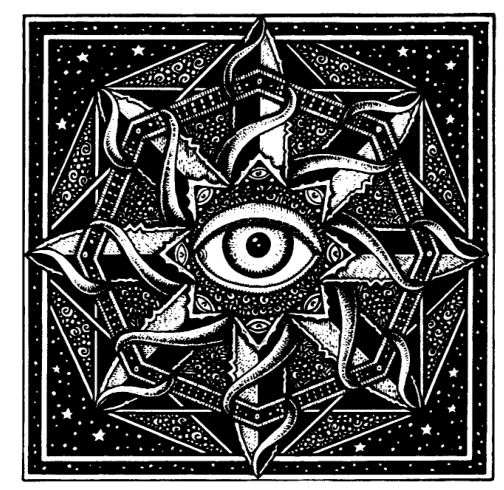
GW has been forging its narrative with pieces of other settings forever.
Next: Elric must die!
Stormbringer eats 1d4 PCs per turn
Original SA post Stormbringer 5th EditionStormbringer eats 1d4 PCs per turn
Time for the GM section! It starts with advice for rookie GMs. They should at least make sure how skills and combat work and read Elric of Melniboné and Stormbringer to get a feeling for how adventures should play out. They should also read through published adventures if they mean to play it, or make sure that the adventures they make themselves have chances for roleplaying, consequences for allegiances, and generally feel Moorcock-like. They should also have a table large enough to sit all players, enough chairs, pen and paper, copies of the character creation worksheet and common tables like Resistance, Parrying, Dodging and so on. Oh, and the GM should keep the corebook - the players can buy their own books if they want the rules, dangit.


His hair, ruined!
There's some advice on building a plot and having excuses for PCs to roll together. They can all be applying for the same job offer, have a common friend in need and so on. Mass combat should be decided beforehand by the GM, or by using miniature or relevant board game rulesets, though the translation notes that the Sailing in the Seas of Fate sourcebook has rules for naval combat. There's also useful notes to keep in mind for adventurers , the opposition, the effects of Chaos in others, and more. There's also an optional rule here to give characters +1 to Law for each skill they get to 80% and for every 20% above it, just like sorcerers get +1 to Chaos for learning or using a spell. Enchantments are basically magic items with qualities of their own, instead of the Stormbringer standard of shoving a demon inside an item and calling it a day. There's an arrow of Law that deals extra damage to Chaotic targets, a Chaotic rapier that bends to strike at armor joints, a book that can answer questions about the past (but fail three POW x3/x2/x1 rolls in a row and the character using it gets a bad case of Wikipedia addiction), and more. These are neat, though not strictly necessary.
Then we get to allegiance from the GM side. It notes that resurrection of a character is only possible by asking a Lord of Chaos or Law, since the Balance doesn't intervene against death. An ally gets a 1% chance of having their patrons listen, while a Champion gets 3%. There's also a table here with examples of the things that make people gain and lose allegiance points. These encompass a lot of stuff, and while they can only affect one single allegiance score at a time PCs will run across these all the time, so even Knighto McLawton will have Chaos points and D'ck'ss Wizardinia will score Law points. Loving someone? +3 Balance. Killing someone? +1 Chaos. Binding an elemental? -1 Balance. Healing someone with a deathly illness? +1 Balance. Saying a meaningful lie? +1 Chaos or +1 Law. Imprisoning someone? +1 Balance or +1 Law. Releasing someone? +1 Chaos or +1 Balance. Rejecting charity? +1 Law. Rescuing someone in danger? +1 Chaos, +2 Balance or +1 Law. Killing a demon? +(1/10 demon's POW) Law. Killing an elemental? (+1/10 elemental's POW) for Chaos or Law. Generally these happen once per session of gaming.
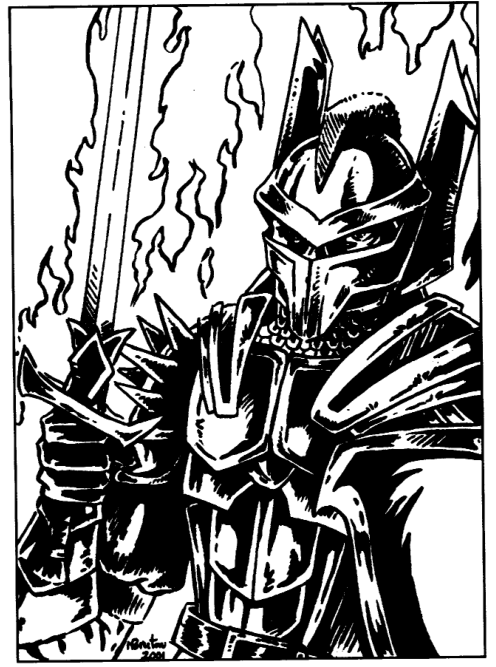
Prince Gaynor, a former Champion of Balance now corrupted by Chaos. He's actually from the Corum of the Scarlet Robe stories, but he cameos in an Elric yarn.
Non-human races! Players may want to play one of these, and if the GM disagrees then the player can play it on a 01 in 1d100 roll. Melnibonéans are dicks, of course. They start with 2d8+2 in most stats except DEX (2d8+4) and INT, POW and APP (2d8+8) They get +20% to three different Art skills, Writing, Appraising, Million Spheres, Riding, Natural World, Oratory, Orienteering, Potions, First Aid and one weapon class. The Witch Sight spell is a skill for them that starts at 30%. Their default skill scores are mostly the same as humans but they're a little worse in unarmed combat, and they start speaking Melnibonéan instead of the Common Tongue, which means a PC will have to spend points in this to talk to other PCs. They also get 250 skill points to start with, and with enough POW to cast spells they can also have half their INT in spells to start. A successful Luck roll gets them up to three bound demons with 1d8 per stat (3d8 for POW) and a five-point power. They also get valuable armor (up to Melnibonéan half-plate), a stable of horses and fabulous wealth in the Dreaming Isle, and ten times what a regular adventurer gets in pocket money. On the other hand, they must've had a good reason to leave Imrryr, and they'll be mistrusted and feared in the Young Kingdoms: penalties to Art, Fast Talk, Negotiation and Oratory and other skills. The GM may also decide to add as disadvantages an Addiction to a certain drug (the character starts with 1d6 days' worth of drug doses, the GM decides the effects of withdrawal) or a Psychological Disorder (sadism, melancholy, etc. - POW x 4 roll to avoid suffering an episode during a tense moment). Half-Melnibonéans are half human and half Melnibonéan, of course. They get 2d8+2 for STR and CON, 2d8+3 for SIZ and DEX, and 2d8+5 for INT, POW and APP. They're similar to Melnibonéans in terms of skills and sorcerous goodies, but they only get five times the starting money and no valuable inheritance. The penalties for dealing with Young Kingdoms folk should be lesser than for full-blooded Melnibonéans. Melnibonéan Slaves are humans or half-Melnibonéans. They get -2 CON, +2 DEX and +1 APP as default modifiers, but the GM may allow the player to shift these mods around. A successful Luck roll means the slave's master "gifted" them a demonic power. They start with valuable jewelry and clothes for 2d8x100 bronzes, a ceremonial dagger that deals 1d4+3 damage and is worth 225 bronzes and an addiction or mental illness at the GM's choice.
The Myyrrhn are proud winged people. Though not all of them actually have wings: Luck roll to see if the character has them. A winged character has a MOV of 11 while flying and 7 on the ground, while non-winged Myyrrhn have 8 MOV. They roll their stats with d8s instead of d6s, start with 250 skill points and get +20% to Art, Search, Disguise, Dodge, Appraise, Natural World, Conceal Object, Trade, First Aid, Jump, Climb and a weapon class. Winged Myyrrhn get Fly as a skill, non-winged Myyrrhn get Ride instead. They're sorcerous adepts and can start with half their INT in spells with the appropriate POW, while a Luck roll gets them a single bound demon. Another successful Luck roll and the sacrifice of one POW gets them the True Name of a sylph as a gift from Lassa.
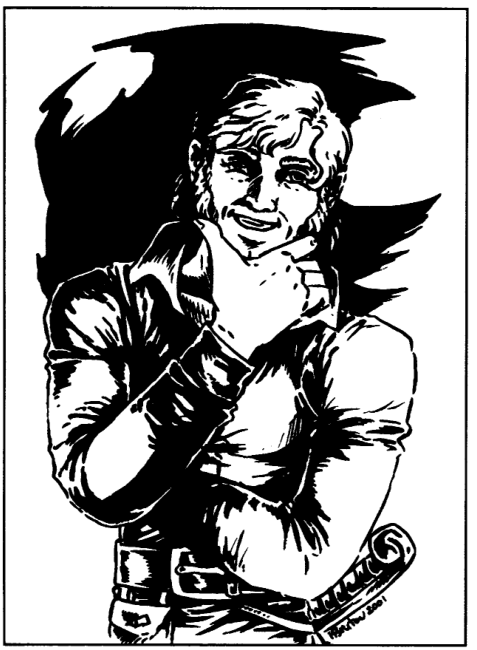
Moonglum looks cool, considering he's supposed to be butt-ugly.
Then there's a number of generic NPCs (generic allegiance agents, archers, assassins, thieves, guards, knights, stable grooms, bar maids, etc.) and creatures from the books. It is warned that many of these could almost overpower Elric, so the GM should feel free to reduce their stats to challenge the PCs properly. Many of them are one-shot enemies from the books: there's Pigs, Snake and Thing from Elric of Melniboné, for instance, and the game notes that they extrapolate stats for the Pigs since Elric and Rackhir waste them quickly once they're introduced. There's the Melnibonéan dragons , of course, that breathe acid poison instead of fire (it has a POT of the dragon's POW and deals 1d6+4 damage per turn); or Bellbane, the "mist giant" from The Weird of the White Wolf that takes half damage even from magic weapons and prefers to crush enemies slowly with its 43 STR and then bite them for 1d8+4+3d8 damage. The Devil Riders of Pan Tang
 are seasoned human warriors that fight riding a freaking Chaos velociraptor and with a trained tiger alongside. The
Butterfly of Chaos
is a Theleb K'aarna summon that almost murders Elric until he remembers how to summon a Beast Lord that eats it whole, but it can get weapons stuck to its body and gore enemies for 2d8+3d8 damage.
are seasoned human warriors that fight riding a freaking Chaos velociraptor and with a trained tiger alongside. The
Butterfly of Chaos
is a Theleb K'aarna summon that almost murders Elric until he remembers how to summon a Beast Lord that eats it whole, but it can get weapons stuck to its body and gore enemies for 2d8+3d8 damage.
But the showcase piece of the chapter is the heroes list, with important NPCs from the entire saga. As per the rules, most of them have varying allegiance scores even if they're focused on one side or the other: Duke Avan Astran has Chaos 13, Balance 38 and Law 62, while Elric's first love Cymoril has Chaos 41, Balance 35 and Law 10. One of the two exceptions is Jagreen Lern , the Theocrat of Pan Tang that has a score of Chaos 840, Balance -600 and Law 0 (literally the most evil NPC) and is also a walking TPK with demons up the ass and weapons that have good odds of wasting at least 1 PC per attack. Still just 17 HP, but good luck getting to hit him. One weird thing with this chapter is that many characters get random demon gear that doesn't quite show up in the books: Moonglum gets some demonic leather armor with eyes on his back so that he can see where all attacks come from, while Magum Colim (Elric's admiral) has a spear that returns to his hand when he throws it. There's also some strange choices in the NPCs to show - there's Oone the Dreamthief, from a 2001 story (dream magic to be written up in a future supplement!), but Sharilla, the Myyrrhn woman that is Elric's main squeeze during the search for the Dead Gods Book in the main saga is nowhere to be seen.
As for Elric himself, his STR and CON are pitiful at 5. Of course, he's got his drugs that increase them to 15 each (or 1d10 if Elric has to scrounge herbs if he's in the ass end of the world, POW x 2% roll) and STR 25/CON 20 with Stormbringer itself. His HP score also changes with these stats, going from 10 to 23 HP. He's a a decent swordsman with a 105% skill with it, and not only knows pretty much every spell in the game but also, being the legal Emperor of Melniboné and thus heir to a buttload of contracts and pacts, can basically call on any Beast or Plant or Elemental Lord that he requires. He can also try calling on his patron Arioch, but just like in the books his help is far from constant. A group of PCs could theoretically overwhelm Elric if the GM doesn't fiat his rescue away. The only problem is Stormbringer itself, which actually has a NPC stat block of its own. It has ridiculous stats for a sword, with a POW of 70 (the translation wonders if Stormbringer hadn't bound Elric instead of the opposite) and a demon skill of 880%, which is how Elric lays waste to everyone around him. It deals a staggering 17d10+1d6 damage, but also has a Drain POW (that is to say, souls) effect that drains 1d100 POW from the target on a hit and increases his STR or CON in one per two POW points up to the maximums of 25 and 20. With a DEX of 20, he could deal up to 4 220% attacks per turn, so he stands a very good chance of murdering a PC party on his own. Stormbringer is fickle, though: like in the books, it can get too full of souls and leave Elric to fight using his skill alone, though that takes "tens of thousands of points", and if it absorbs 21 POW or more in one go the power surge will knock Elric on his ass. Mournblade, Stormbringer's twin blade, has the same stats.
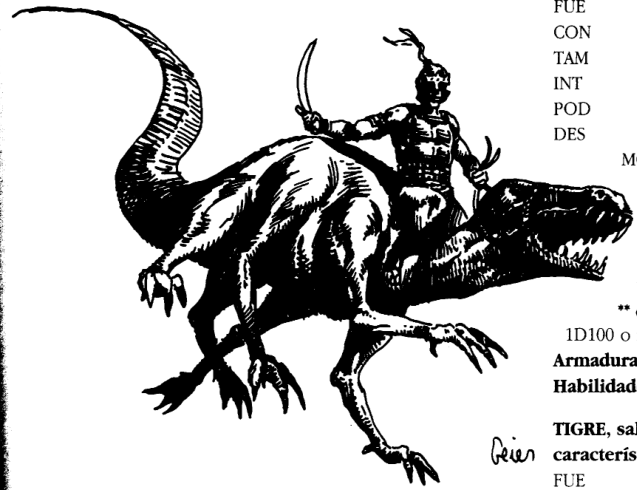
Why would you ever not play a Devil Rider?
Then there's two ready-made adventures but this post is getting long enough already! The first one, The Weight of Doom , is pretty lame: the characters end up sought out by a follower of Balance, who is pursued by both an agent of Chaos and one of Law. It's nothing but "NPC talks to PCs, PCs react, then the next NPC shows up" and really, there's not much else to it. A printout of the values of Law, Chaos and Balance would be much more useful to players. The second one, The Thought that Counts is more interesting. The PCs are hired by a Purple Towns merchant to recover a small figurine from a guy that owes him money. The thing is, he had already given up the figurine, but somehow he managed to steal it back. The guy is secretly a sorceror and had a demon bound in the figurine to bring it back, and it's up to the PCs to find out! They could end up confronting the sorceror directly, somehow subduing the bound demon so that it doesn't teleport around, or even call in the Church of Law since demon summoning is illegal in the Towns (but the Church agents will break the cursed figurine in the process, so much for the reward!) The chapter rounds up with notes on converting old Stormbringer material to this edition and six ready-made PCs.
Next: a Lawful Good Agent of Chaos.
It was the early 2000s, everyone was doing it
Original SA post Stormbringer 5th EditionIt was the early 2000s, everyone was doing it
Okay, time to actually wrap this up! Strictly speaking, I have already covered the Stormbringer 5 core book. But, since I'm working off the Spanish edition, there's an extra appendix here. Elric d20, as it is called, is the rules portion of the Dragon Kings of Melniboné sourcebook for D&D 3E, way back when. As the game puts it in the back cover, "enjoy with both systems the boundless Multiverse of Michael Moorcock!" Alright then.
Character classes! All the 3E basic classes are there, and most indicate a certain origin for the adventurer. Barbarians come from degenerated or undeveloped places like Dorel, Pikarayd, Oin and Yu; Druids and Rangers show in places where the Elemental Lords are worshiped; civilized nations make Fighters, Bards and Rogues; the great Churches of Law and Chaos pop out Clerics and Paladins, while Monks follow the path of Balance. Races, on the other hand, change in availability: elves and half-elves are replaced by Melniboneans and half-Melniboneans, the degenerated humans of Org are represented by half-orcs, and a faithful representation of Moorcock's tales excludes dwarves, halflings and gnomes. Not that you can't play with one of those, but they'll be very, very rare (perhaps literally the only representative of their kind across the whole of the Young Kingdoms). They may come from another plane, a far off land, be a remainder of Dharzi experiments or a new creature from the Chaos beyond the edge of the world. Melniboneans and half-Melniboneans have no level adjustment like other "bad elf" races, but still get neat tricks like Witch Sight (treated as a skill, always class skill for them) and bound demons. Myyrrhn characters can fly 50% of the time, and unwinged Myyrrhn move at 35 feet per round. Also no level adjustment!

For everyone else, there's nations. These are mostly the same as in the BRP section, but interestingly Allegiance stats are based on origin rather than just shoving three points into one at chargen. For instance, Argimiliar starts with Chaos 0, Balance 1d6 and Law 1d10, while Dharijor gets Chaos 2d8, Balance 1d4 and Law 0. Nations also get some cultural skills (always considered class skills) and stuff like the armor that any adventurer of a martial class gets. Some nations also get special chargen rules: Nadsokor PCs roll 3d6 down the line for stats, but the sum total of their stat points - 75 equals the number of extra skill points they get. Also, Monks can only be from Tanelorn, and adventurers can only join Tanelorn in-game and with GM permission. Which does mean you can't be a Monk at chargen - once initiated in Tanelorn, Monk becomes a PC's favored class.
There's some dull Open Content stuff like feats for close formation fighting, setting a spear against a charge (did that really need a feat?) and the Myyrrhn dive attack with their special spears. A "new" class, the Sailor, is literally just the Expert NPC class with a sailing-themed skill list. The most interesting bit is Heroic Actions: a character that hits 0 hit points or less can make a Fortitude save with a penalty equal to their negative hit points against a DC of 15. If successful, they get a partial action, then lose a further 1d3 HP. It is really just meant for desperate actions.
Allegiance is rated just like in the BRP rules. You can gain and lose points pledge your allegiance to one of the cosmic powers and undergo Apotheosis with a few rules changes (for instance, killing an elemental gives the elemental's hit dice in allegiance points). The funkiest bit is that Allegiance does not interact with D&D Alignment: it is perfectly kosher to have a Lawful Good Paladin PC in the cult of Arioch, or some Chaotic dickhead at the service of Donblas. It is necessary that both GM and players can set both apart, says the book, but seriously what?
Magic! Wishes are gone, you gotta get in touch with a Lord. Communion is deity-specific: you need to be a believer, and the deity will only know about things it cares about. Consecrate can only be used by Church clerics, and if you keep using Summon Monster to get a bunch of expendable bags of XP you run the risk of having a Beast Lord or similar (Colossal-sized) to put the fear of itself into you, and after that you can never use Summon Monster to get that creature again. Demon summoning is based on XP and Wisdom rather than POW. Elementals follow their D&D Monster Manual rules, rather than adapting the ones used in the BRP version. All magic is Chaotic, but some spells are extra Chaotic (they get the Chaos descriptor) while some are more Lawful (Law descriptor) Some spells change according to the caster's Allegiance: a Lawful caster won't be summoning evil or chaotic beings anytime soon with Summon Monster and viceversa. There are no spells that interact with Good or Evil, only with Balance, Chaos or Law. The highest score in an Allegiance is used to determine whether a character is affected by, for instance, Detect Chaos. The translation dryly notes that the magic in the stories has a much different focus. Each of the Lords of Law and Chaos gets their own relevant spheres: Balo has both Law and Chaos, for extra fuckery.
And that's about it, I guess. Stats for creatures and NPCs follow (Elric is a Fighter 8/Mage 20 character and Stormbringer deals 2d6+4d10 damage plus 1d100 CON drain, if you care) but this book is down and out. Thanks!